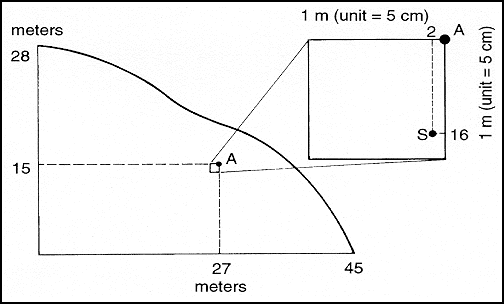
Simple random sampling is a more precise method of taking soil samples and is less biased by the sampler than judgment sampling. Judgment sampling is used where soil or cropping differences are noticeable and where the focus of the survey is only on one particular area of the field. Random sampling is needed where the soil differences are not immediately noticeable by color, texture, etc. and selection of representative samples becomes more difficult.
Simple random sampling could be used, for example, to take a soil sample in a small experimental plot where high accuracy is needed. In this case, sampler bias must be eliminated as much as possible for the sample to be representative of the entire plot.
Following are the steps needed to take a random soil sample:
Obtain a map or sketch of the area to be sampled
Decide upon a scale for the sketch: if it is a large field, you may decide that 1 cm equals 100 m; if a small field, 1 cm could equal 1 m. (Use any convenient unit of measurement such as feet, paces, yards, etc. if preferred)
Select a corner of this map and draw two lines connected at one point at right angles to each other (Figure 2). They do not need to be equal in length. Each will extend from the point at which they meet to the farthest point at the edge of the field. The important thing is to cover as much of the field as possible using two lines joined at one end. These lines are usually called the "axes"
Using the map scale units you decided on, determine the length of the two axes. (Example: one axes is 28 cm and the other is 45 cm, corresponding to 28 m and 45 m in the field)
Number slips of paper from 1 to the highest number of units on either of the two axes (Example: numbers 1 to 45). Place the numbers in a box and shake well
Draw any one number between 1 and 45 from the box at random without looking (for example 27). Return the number to the box and draw a second number between 1 and 28 (for example 15)
Plot the point of the first number on its axes and the other number on the other axes. These two points are called "coordinates"
Plot the point where the coordinates intersect in the field (Point A in Figure 2). This is the approximate location where the sample will be taken
Draw two new axes parallel to the first, at right angles, starting from the point you just marked (see enlarged insert in Figure 2)
Roughly measure the width of your sampling device. (Example: if you are using an auger, the auger might have a diameter of 5 cm)
Divide the unit of measurement you decided on for the field by the diameter of the sampling device. (Example: We chose 1 m, which is 100 cm; 100 cm/5 cm = 20
Put slips of paper numbered 1 to the number you just calculated into a box and shake. (Example: papers numbered 1 to 20)
Draw two slips of paper. These are your new coordinates. (Example: 2 and 16)
Find the spot in the field that corresponds to the intersection of the coordinates (point S). This is where you take your sample (Figure 2)
Using the field units chosen, measure out in the field what you have plotted on paper, and take the sample with your sampling device.

Figure 2. Random sampling.